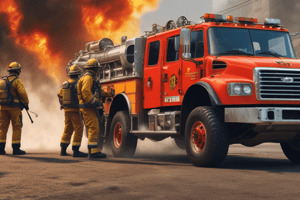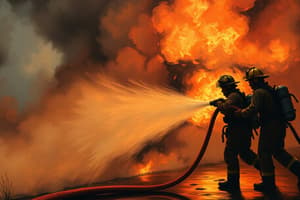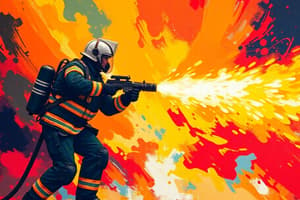Podcast
Questions and Answers
What is the priority of the Phoenix Regional Fire Department during fire attack?
What is the priority of the Phoenix Regional Fire Department during fire attack?
- Focusing solely on victim rescue operations.
- Prioritizing property conservation above all else.
- Implementing an effective fire attack strategy. (correct)
- Waiting for additional resources before initiating any action.
Which of the following is a critical factor in gauging possible fire attacks?
Which of the following is a critical factor in gauging possible fire attacks?
- The complexity of the compartment, flow path, and exposures. (correct)
- The color of the smoke emanating from the structure.
- The number of fire hydrants available in the immediate vicinity.
- The age of the building and materials used in its construction.
What is the MOST important reason for coordinating ventilation with fire attack?
What is the MOST important reason for coordinating ventilation with fire attack?
- To minimize property damage caused by smoke.
- To create a dramatic visual effect for bystanders.
- To reduce the amount of water needed to extinguish the fire.
- To improve firefighter safety and survivability. (correct)
During interior fire attack, where are suppression efforts MOST effective?
During interior fire attack, where are suppression efforts MOST effective?
How does coordinated ventilation during a fire in an unventilated compartment impact firefighters?
How does coordinated ventilation during a fire in an unventilated compartment impact firefighters?
What is the primary goal of a transitional fire attack?
What is the primary goal of a transitional fire attack?
What is the MOST important consideration when determining appropriate water volumes for fire attack?
What is the MOST important consideration when determining appropriate water volumes for fire attack?
In the context of fire control, what does 'size-up' primarily involve?
In the context of fire control, what does 'size-up' primarily involve?
When is an interior fire attack typically the preferred option?
When is an interior fire attack typically the preferred option?
What is the definition of residential fires, according to the procedure?
What is the definition of residential fires, according to the procedure?
What is the maximum interior distance, according to the 150-foot rule, that a fire company should operate inside a structure?
What is the maximum interior distance, according to the 150-foot rule, that a fire company should operate inside a structure?
Why is it crucial to have an of understanding the types of firefighting equipment when dealing with fire attack from standpipes?
Why is it crucial to have an of understanding the types of firefighting equipment when dealing with fire attack from standpipes?
When operating in an offensive strategy, what is the minimum GPM that should be considered?
When operating in an offensive strategy, what is the minimum GPM that should be considered?
According to structural conditions, smoke conditions, and ventilation profile, what critical decision does the Command make?
According to structural conditions, smoke conditions, and ventilation profile, what critical decision does the Command make?
What water flow is expected from a 2 1/2" hose line with smooth bore nozzle?
What water flow is expected from a 2 1/2" hose line with smooth bore nozzle?
According to fire control, what is the aim of a fire attack within a structure?
According to fire control, what is the aim of a fire attack within a structure?
Commercial building fires differ from residential fires by
Commercial building fires differ from residential fires by
According to nozzle reaction standards, what is the maximum pounds, for single firefighter operations?
According to nozzle reaction standards, what is the maximum pounds, for single firefighter operations?
When is a fire attack against the flow path acceptable, according to fire control principles?
When is a fire attack against the flow path acceptable, according to fire control principles?
What are the size standards of Phoenix Engine Company?
What are the size standards of Phoenix Engine Company?
Flashcards
Standard Operating Procedure
Standard Operating Procedure
Stabilizing fire conditions with an aggressive, well-placed fire attack.
Transitional Attack
Transitional Attack
An attack from the exterior to change conditions prior to interior entry.
Fire Attack
Fire Attack
Using adequate water volume (GPM) based on fire conditions and heat release rate
Fire Attack Strategy
Fire Attack Strategy
Signup and view all the flashcards
Residential Fires
Residential Fires
Signup and view all the flashcards
Firefighting in Multi-Story Buildings
Firefighting in Multi-Story Buildings
Signup and view all the flashcards
Effective Fire Suppression
Effective Fire Suppression
Signup and view all the flashcards
Transitional Attack
Transitional Attack
Signup and view all the flashcards
Getting Water Flow
Getting Water Flow
Signup and view all the flashcards
Air Movement and Interior Pressures
Air Movement and Interior Pressures
Signup and view all the flashcards
Coordinated Ventilation
Coordinated Ventilation
Signup and view all the flashcards
Commercial Fires
Commercial Fires
Signup and view all the flashcards
Residential Fire Tactics and Flow Rates
Residential Fire Tactics and Flow Rates
Signup and view all the flashcards
Well-Executed Fire Attack
Well-Executed Fire Attack
Signup and view all the flashcards
Offensive Strategy Water Flow
Offensive Strategy Water Flow
Signup and view all the flashcards
Fire Control in Commercial Fires
Fire Control in Commercial Fires
Signup and view all the flashcards
150 Foot Rule
150 Foot Rule
Signup and view all the flashcards
Standpipe Fire Attack
Standpipe Fire Attack
Signup and view all the flashcards
Adequate Water Supply
Adequate Water Supply
Signup and view all the flashcards
Offensive Strategy
Offensive Strategy
Signup and view all the flashcards
Study Notes
- The standard operating procedure is to stabilize fire conditions with an aggressive fire attack.
- Initial attacks should overwhelm fire with well-placed water, from the most advantageous position.
- Transitional attacks should be considered when changing conditions on the exterior before entry.
- Fire attack must utilize adequate water volume for fire conditions, heat release rate, and structure size.
- Fire attack also protects victims/property, and prevents fire extension into exposed structures.
Principles of Fire Attack
- Implement effective fire attacks as the most fundamental job.
- Drive the strategy with size-up, risk management, and rescue profile.
- Determine the complexity of compartments, flow path, and exposures.
- Understanding fire behavior and water application mitigates hazards.
Residential Fires
- Residential fires include any structure where the community resides, such as houses and apartments.
- Thorough size-up of life safety potential is important for fighting fires in these structures.
- Perform search and rescue efforts simultaneously with fire attack for the best outcomes.
- Extinguishing the fire improves the possibility of savable property.
- Effective fire suppression includes understanding the principles of fire behavior.
- Interior surface cooling with water is the most effective tactic.
- An effective fire attack requires adequate water volume along with the fire area's size and volume.
- Hose line deployment requires adequate length and size for the desired water flow.
- Transitional attacks involve water application from the exterior to change interior conditions.
- Sizing up the fire structure and distances, which is a critical function of Company Officers.
- Interior fire attack is best when ventilation limited conditions are discovered during size up.
- Suppression efforts through interior flow paths are most advantageous.
- Water volume, effective hose stream patterns, and nozzle manipulation are critical for cooling
- Fire attack and coordinated ventilation provide greater survivability, safety, and property conservation.
- Coordinated ventilation exhausts heated gas and smoke, changing the flow path direction.
- Understanding air movement and interior pressures are evaluated when sizing up a fire attack.
- Fire suppression from the most advantageous position impacts thermal insult and pressures.
- Coordinated ventilation supports fire control.
UL-FSRI Tactical Considerations
- There can be survivable spaces on arrival.
- Nothing showing means nothing.
- Flow path and suppression must be considered together.
- Interior suppression with only smoke showing is a factor.
- The closest door should not dictate line placement.
- Attack exterior fires with the fire showing from the entry point.
- Initiate fire attack on the same level as the fire.
Commercial Fires
- Commercial buildings are for business, manufacturing, storage, or are non-residential.
- They vary in size and can be free-standing, connected, or multi-story, and can contain hazards.
- Commercial structures are less compartmentalized than residential ones.
- Commercial occupancies in the Phoenix area can exceed 1 million square feet.
- Residential fire tactics and flow rates are not used in commercial fires.
- NFPA 1710 target flows should be the minimum for commercial fires.
- Commercial building fires can have life safety potential.
- Ability to impact that life safety problem is the difference between commercial and residential building fires.
- Search operations in confined residential fires are easier than in large, complex commercial fires.
- Extinguish commercial fires as quickly as possible.
- Commercial fires require an understanding of fire behavior and involve large areas and loads.
- Overwhelm the fire conditions with a well-executed fire attack.
- Support building fire suppression systems as early as possible.
- Water volume and aggressive exposure protection are critical.
- Direct all resources to fire attack operations from the onset, unless a known rescue is present.
- Crews assigned to rescue must reassess the conditions, stability, and risk management plan.
- Support fire attack operations and manage the risk management plan.
- Attack the fire with large volume hand lines, flowing a minimum of 250 GPM.
- NFPA 1710 standard is a minimum of three hand lines with an overall volume of 500 GPM.
- Use a transitional attack from an exterior position until interior entry.
- Water application is done from interior or exterior to gain control of the conditions.
Ventilation
- Coordinate ventilation in commercial fires planned with fire behavior principles.
- The size of commercial buildings creates the greatest ventilation challenges.
- Consider the size of ventilation exhaust points to improve interior conditions.
- The use of windows and doors may provide better horizontal ventilation.
- Vertical ventilation challenges are creating a large enough opening for the building volume.
- The IC must determine the potential and available options to ventilate with Sector Officers.
- Coordination prevents rapid fire growth.
150 Foot Rule
- No fire companies should operate beyond their ability to retreat to a safe refuge.
- It defined as the maximum distance any company should advance and operate inside a structure
- This distance is 150 feet, determined by the standard lengths of attack lines and SCBA air.
- Variables limit this distance, including smoke, building construction, occupancy, and physical effort.
- It defined as maximum distance any company operates on the interior of mid/high-rise buildings.
- This is measured from any area of safe refuge to the end of the hoseline.
- Areas of safe refuge are stairwells, landings, or other areas protected by doors.
Fire Attack From Standpipes
- Phoenix construction requires building suppression systems.
- Firefighting personnel need understanding of firefighting equipment.
- Consider commercial and residential occupancies from 1 story to 40 stories.
- Standpipe firefighting has considerations based on building systems.
- Critical keys when starting a fire attack from a standpipe:
- Ability to provide adequate water supply.
- Ability to provide high pump discharge pressures.
- Ability to provide adequate water pressure.
- Ability to provide an external shut off.
- Ability to determine adequate flow.
- Ability to flow recommended GPM for initial and subsequent attacks.
- Simultaneous ability to flow GPM from standpipes on multiple floors.
- Knowledge and understanding of pressure reducing systems.
- Ability to stretch hose lines from standpipe connections to the fire location.
Fire Attack Equipment and Standards
- The Phoenix Fire Department has flexible hose and nozzle packages.
- Firefighters are proficient in these tools.
- Company and Sector Officers determine the most effective fire attack operations.
- Incident Commanders determine fire attack requirements and provide direction.
- Residential water flow – 150 GPM with 1.75” hose lines with automatic nozzles.
- Commercial water flow – 250 GPM with 2” and 2.5” hose lines with fixed gallonage.
- Portable appliances water flow- 500 GPM.
- Deck gun or ladder pipe appliances water flow – 600+ GPM.
- Phoenix Fire Engine Companies carry:
- 1 3/4" hose line with automatic nozzles (x2 minimum).
- 150' crosslay
- 200' crosslay
- 100' to 150' front bumper line
- 1 3/4" hose line with automatic nozzles (x2 minimum).
- Automatic nozzle (75/45 psi nozzle pressure for 70 to 200 GPM)
- 2" hoseline with smooth bore nozzles (x1)
- 200' crosslay or rear mount depending on apparatus manufacturer
- 2" hoseline with smooth bore nozzles (x1)
- Smooth bore nozzles with 1 1/16” tip (240 GPM at 50 psi nozzle pressure)
- 2 ½” hose line with smooth bore nozzles (1 or 2 depending on apparatus manufacturer)
- 200' rear mount (1 or 2 depending on apparatus manufacturer)
- 2 ½” hose line with smooth bore nozzles (1 or 2 depending on apparatus manufacturer)
- Smooth bore nozzle with 1 3/16” tip (300 GPM at 50 psi nozzle pressure)
- Blitz Monitor with solid bore or peripheral tips (up to 500 GPM)
- Firefighters must operate specific hose and nozzle packages at the required water flows.
- Nozzle reaction is defined as the force exerted by the fire nozzle on the Firefighter.
- The standard for single Firefighter operation: 70 lbs.
- Anything above this requires additional Firefighters or operations from the fixed positions.
Fire Attack Hose Line Operations
- 1 3/4” hoseline w/ 75 psi automatic nozzle @ 150 gpm: 1 firefighter (65 lbs. nozzle reaction)
- 1 3/4" hoseline w/ 45 psi automatic nozzle @ 150 gpm: 1 firefighter (60 lbs. nozzle reaction)
- 2” hoseline w/ 1 1/16” solid bore nozzle @ 240 gpm: 2 Firefighters minimal operation (85 lbs. nozzle reaction)
- 2 ½” hoseline with 1 3/16" solid bore nozzle @ 300 gpm: 3 Firefighters minimal operation (110 lbs. nozzle reaction)
- Standard Phoenix Engine Company apparatus carry 500 gallons of water (+ or - 50 gallons).
- Establishing an uninterrupted water supply for declared working fires is critical.
- First due Engine Company will not always establish a hydrant supply line with at least 450 gallons onboard
- This include fires with an unknown location or route to the location in a neighborhood or apartment/business complex
- Fires in a high-rise building, fires with a known rescue situation are others when a hydrant supply will not be set up
- Ensure proper water supplies in all tactical positions.
Incident Commander Responsibilities
- The Incident Commander ensures effective fire attacks.
- The Incident action plan will depend on the incident size and strategy.
- Command must define Offensive/Defensive Strategy based on risk management and will consider:
- Rescue profile of occupants
- Fire/smoke volume
- Fire extent
- Structural conditions
- Structural ingress and egress
- Smoke conditions and ventilation profile
- Available resources
- Critical Command decision is the Offensive/Defensive Strategy:
- Offensive Strategy: exterior/or interior fire attack with tenable spaces and search operations.
- Defensive Strategy: fire attack on the fire structure from the advantageous positions outside of the hazard zone.
Basic Offensive Plan:
- Assume command.
- Incident size up and determination of critical factors.
- Initial fire attack from the most advantageous position with most appropriate water volume.
- Conduct a primary search in coordination with fire attack when possible.
- Provide coordinated support activities.
- Support fire attack from the next most advantageous position with appropriate water volume.
- Address loss control and property conservation.
- Evaluate actions and revise strategy and tactics as necessary.
Basic Defensive Plan:
- Assume command
- Incident size up and determination of critical factors
- Write off what is lost, identify, and protect savable exposures.
- Attack the fire from the most advantageous positions with most appropriate water volume.
- Support the needs of a high-volume fire attack.
- Ensure adequate resources to support the operation fully.
- Address fire extension, life safety, and loss control.
- Evaluate actions and revise strategy and tactics.
Studying That Suits You
Use AI to generate personalized quizzes and flashcards to suit your learning preferences.




